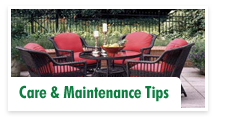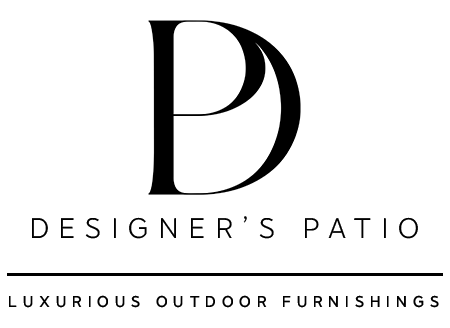
Care & Maintenance
Stain Removal
A stain doesn’t mean the end of your furniture or cushions. These helpful guides can help you beat those tough stains.
Table Tops
Faux Stone Tops: These are made from non-porous materials and are easily cleaned with soap and water. On a regular basis, use a mild soap and soft rag to scrub the surface and rinse clean with water.
Natural Stone Tops: Regular cleaning using a mild soap and water with a sponge is all that is required. Ancient Mosaics recommends the use of a ph-neutral cleaner like Simple Green to clean their table tops. Spills should be wiped up quickly to avoid any possible staining. The use of coasters on all stone top tables is recommended.
Stone Top Tables should be re-sealed every 6-12 months. Use a high quality stone sealer, such as the Ancient Mosaics Sealant (sold at Designer’s Patio). Follow the instructions carefully when re-sealing the table top. Natural Stone tops will fade in direct sunlight over time. This fading is a natural process and will be more noticeable on brightly colored stones. Stone tops may be re-finished professionally.
Copper Tops: Keep top as dry as possible, clean up spills immediately and use coasters and placemats. Clean with stainless steel appliance cleaners. Do not use a metal polish as it will remove the original unique patina. Without recommended care and maintenance, continuous or prolonged exposure to water will oxidize your 100% copper top and hard water deposits will appear that are difficult to remove.
Aluminum and Iron Frame Finishes
Frames should be kept clean. Do not let dirt build up on the metal frames. Periodic cleaning with mild soap and water is recommended. Simply wash with mild soap and rinse thoroughly. Please do not use abrasive materials or strong detergents. NOTE: DO NOT USE WAXES ON TEXTURED FRAME FINISHES.
Scratches: Seasonal touch up of your furniture is recommended. Touch up paint or pens that will cover scratches or chips are available from most manufacturers. Call Designer’s Patio to determine what is available for your furniture.
Storage: All Aluminum furniture should be stored in an upright position to allow for proper water drainage. Factory drilled holes in the bottom of the furniture frames serve as a drainage system. If furniture is placed upside down it will not allow water to drain, which can cause freeze damage.
Teak Furniture
If left to age naturally, the surface of the teak will gradually change to a soft, silver-grey as the pigments in the surface layer of the wood start to fade away. If you would like your teak to age naturally, the only maintenance required is cleaning your furniture with mild soap and water or a teak cleaner (available at Designer’s Patio) once or twice per year. Clean the wood with a rag or sponge, and rinse thoroughly. To protect teak surfaces from staining and to help maintain the silver-grey patina on weathered teak, the use of a Teak Stain Protector is recommended.
To restore the Teak wood to its original color, use a teak cleaner every 6-8 months. Allow the wood to dry thoroughly, then apply a teak sealant. Never use a metal bristle brush, pressure washer or steel wool for cleaning, as they will damage and discolor the surface.
In the case of a stain, first wash the area with warm soapy water. It the stain remains, use Teak Cleaner. The last resort is to sand lightly. Extremely stubborn stains will eventually be bleached out over time with exposure to sunlight.
All Weather Wicker
This product requires minimal maintenance. Use a soft brush, duster or vacuum to remove surface dirt. The furniture can be cleaned with a sponge, using a mild detergent and warm water. Rinse thoroughly and allow the furniture to dry before replacing the cushions on the furniture.
Fabrics and Cushions
Woven Vinyl Fabrics/Woven Blend Fabrics (Sling): Using a sponge or cloth, wash with a solution of soap or mild detergent and warm water. Rinse thoroughly with water and allow to air dry. For more stubborn stains, mix three gallons of warm water with one cup of household bleach and one cup of mild laundry detergent. Do not use solvent-type materials, they will damage the fabric.
Woven Acrylic Poly Fabric/Woven Acrylic Fabric: Using a sponge or cloth, wash with a solution of soap or mild detergent and warm water. Sponge thoroughly with water and allow to air dry.
Furniture Covers
Covers: These are an ideal way to preserve the beauty of your furniture. The best covers are those made of a breathable material that protects the furniture but does not allow moisture and potentially mold to get trapped inside the cover. Treasure Garden’s “rhinoweave” cover, made of a breathable material is available at Designer’s Patio.
Umbrella Care & Maintenance
The most important preventative maintenance for umbrella care is to keep the umbrella closed when it is not in use. The umbrella should be closed and secured with its ties whenever it is not in use. It is best to remove the top section of the pole (that holds the umbrella canopy), and lay it flat when not in use. This is your best defense to prevent wind damage, which is not covered by manufacturer warranty.
Always use a weighted base with your umbrella, even if it is being used with a table. In the event that you are using the umbrella without a table, you must use a free-standing base that is heavy enough to provide support for the umbrella (a minimum of 50 pounds is recommended, but depending on wind conditions a heavier weight may be necessary).
If you want to clean the umbrella, you can simply rinse it with water. If there is a spot that is not removed by rinsing, use a sponge, cloth or soft bristle brush and wash with a solution of mild soap and warm water. Rinse thoroughly with water and allow to air dry.
The maintenance information is provided courtesy of our Manufacturers.



